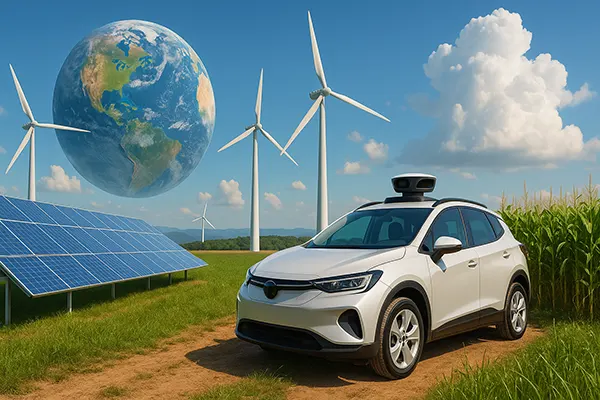
Climate Tech and AI: Modelling Climate Scenarios with Differentiable Simulators
In the face of escalating climate challenges, the integration of artificial intelligence with climate science presents a groundbreaking pathway to predict and mitigate environmental risks. Among these innovations, differentiable simulators are redefining how we construct and test climate scenarios. These simulators, designed to be compatible with machine learning frameworks, allow us to model the Earth’s complex systems with unprecedented precision. Their emergence marks a pivotal shift in how we approach climate adaptation and resilience planning.
What Are Differentiable Simulators and Why Do They Matter?
Differentiable simulators are computational tools that model physical processes while maintaining differentiability — a key requirement for gradient-based optimisation. Unlike traditional simulators, they enable direct integration with deep learning models, allowing systems to be trained end-to-end using real-world data. In climate modelling, this means more accurate predictions through refined feedback loops and adaptive learning cycles.
The key advantage lies in the simulators’ ability to capture continuous gradients across climate variables, such as temperature, precipitation, and ocean currents. This allows AI models to adjust their parameters more effectively during training, improving overall forecast quality. These tools are not only more data-efficient but also drastically reduce the time required for simulation runs.
Moreover, differentiable simulators unlock potential in climate research by enabling “inverse modelling” — a process where researchers can infer unknown climate drivers by observing outcomes. This is particularly useful in tracking sources of pollution or identifying critical tipping points in ecological systems.
Key Areas of Application
One critical application is in simulating extreme weather patterns. Differentiable simulators can help model cyclone paths, heatwaves, or droughts with greater resolution by learning from historical satellite data and climate records. This data-driven refinement improves disaster preparedness and early warning systems.
In agriculture, these simulators are used to forecast seasonal shifts and their impact on crop yields. By integrating soil health, temperature forecasts, and rainfall data, AI-enhanced models support decision-making for sustainable farming practices and food security planning.
Energy systems also benefit. Modelling renewable energy supply and demand under various climate conditions becomes more precise, which is vital for infrastructure planning and national energy grid management amid global decarbonisation efforts.
AI Integration: Bridging Data and Simulation
The synergy between AI and climate simulators hinges on vast data availability. Earth observation satellites, sensor networks, and historical climate databases supply an immense volume of inputs. AI algorithms, particularly deep learning and reinforcement learning, process this data to learn underlying patterns and inform simulation parameters in real time.
One advantage of this integration is the dynamic calibration of climate models. Traditional simulations often suffer from fixed parameters, but AI can adjust them dynamically based on new data inputs, enhancing responsiveness to emerging climate signals.
Additionally, generative models, such as diffusion and transformer-based architectures, are being trained to generate synthetic climate scenarios. These scenarios help researchers explore a broader range of possibilities without relying solely on historical precedents — a crucial step in preparing for novel climate events.
Ethical and Practical Considerations
While the potential of AI in climate science is vast, several concerns must be addressed. One is the risk of model overfitting due to limited or biased datasets. Ensuring data diversity and transparency in AI training processes is critical for maintaining scientific credibility and public trust.
Another issue is the computational cost. Training high-fidelity simulators demands significant energy and hardware resources. Sustainable AI practices, including model compression and energy-efficient architectures, are necessary to align the tech’s impact with climate goals.
Finally, accessibility remains a concern. Bridging the gap between advanced climate simulation tools and communities most affected by climate change — often in developing regions — requires policy support, open-source initiatives, and international cooperation in technology transfer.

The Future of Climate Scenario Modelling
As differentiable simulators become more refined and accessible, their role in shaping climate strategies will expand. Policymakers, scientists, and industries can utilise AI-enhanced forecasts to design evidence-based interventions tailored to specific regional and global challenges.
Climate finance and insurance sectors are already integrating these models into risk assessment frameworks. This allows for more precise estimation of losses under various warming scenarios, informing investments in climate resilience and infrastructure protection.
Furthermore, public engagement with climate models can be transformed. Interactive simulators powered by AI may help educate communities, visualise potential futures, and empower citizen scientists to contribute data — democratising climate science.
Collaborative Opportunities Ahead
Multidisciplinary collaboration is essential to maximise the value of differentiable simulators. Climate scientists, AI researchers, policymakers, and local stakeholders must align their efforts to ensure technological advancements meet real-world needs.
Open research platforms that facilitate the sharing of models, data, and methodologies are fostering a culture of transparency and rapid innovation. These spaces enable faster iteration, reproducibility of findings, and greater community involvement in addressing climate risks.
Finally, institutional support and global cooperation will determine the scalability and ethical deployment of these tools. With sustained investment, climate tech powered by AI and differentiable simulators can become a cornerstone of future environmental governance.